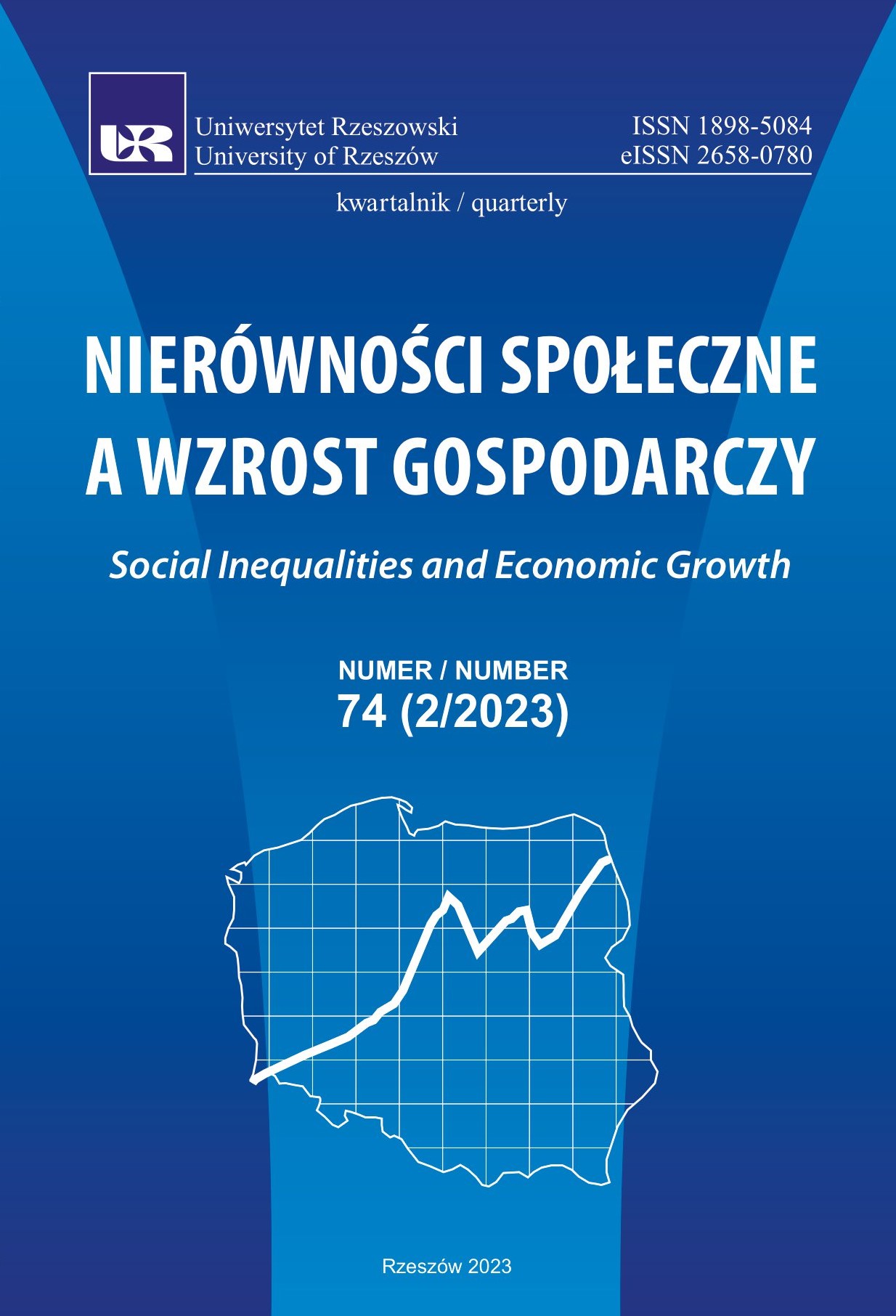Prawo Okuna – weryfikacja z wykorzystaniem panelowego modelu VAR dla polskich województw
DOI:
https://doi.org/10.15584/nsawg.2023.2.4Słowa kluczowe:
bezrobocie, wzrost gospodarczy, analizy regionalne, PVARAbstrakt
Celem artykułu było przedstawienie wyników badań własnych nad relacją znaną w ekonomii pod nazwą „prawo Okuna”. Wykorzystano panel danych dla 16 województw Polski w latach 1995–2019. Jako narzędzie badawcze zastosowano panelowy model autoregresji wektorowej (PVAR), co pozwoliło chociażby na uchwycenie dynamicznego charakteru modelowanej relacji. Do estymacji
parametrów modelu wykorzystano uogólnioną metodę momentów (GMM). Następnie oszacowane zostały ortogonalne funkcje reakcji na impuls (IRF) przy wykorzystaniu dekompozycji Choleskiego. Dokonano także dekompozycji błędu prognozy w 10-letnim horyzoncie.
Prawo Okuna zakłada negatywną zależność pomiędzy zmianami stopy bezrobocia a stopą realnego wzrostu gospodarczego. Pierwotnie zostało ono empirycznie zaobserwowane przez A. Okuna w 1962 roku. Oryginalny współczynnik wymiany wynosił ok. 0,3. Oznacza to, że każdy dodatkowy procent PNB powiązany jest ze spadkiem stopy bezrobocia o ok. 0,3 p.p. Zaprezentowane w artykule oszacowania funkcji reakcji na impuls wskazały na istotność statystyczną wpływu szoków pochodzących od poszczególnych zmiennych. Pozytywny impuls pochodzący od strony stopy wzrostu realnego PKB powodował obniżenie się zmiany stopy bezrobocia (i na odwrót) w porównaniu do ścieżki bazowej. Zaobserwowano również stosunkowo powolne wygaszanie się szoków w modelu. Dekompozycja błędu prognozy wykazała, że ok. 31% zmienności przyrostu stopy bezrobocia może zostać wyjaśnione za pomocą stopy wzrostu realnego PKB. Z kolei zmiany stopy bezrobocia zdołały wyjaśnić jedynie ok. 6% przyszłych stóp realnego wzrostu gospodarczego.
Downloads
Bibliografia
Abrigo, M.R.M., Love, I. (2016). Estimation of panel vector autoregression in Stata. The Stata Journal, 16 (3), 778–804. DOI: 10.1177/1536867X1601600314.
Ball, L.M., Jalles, J.T., Loungani, P. (2015). Do forecasters believe in Okun’s Law? An assessment of unemployment and output forecasts. International Journal of Forecasting, 31 (1), 176–184. DOI: 10.1016/j.ijforecast.2014.03.009.
Baltagi, B.H. (2008). Econometric Analysis of Panel Data. Chichester: Wiley. DOI: 10.1007/978-3-030-53953-5.
Boďa, M., Považanová, M. (2023). How credible are Okun coefficients? The gap version of Okun’s law for G7 economies. Economic Change and Restructuring: Empirical and Policy Research on the Transitional and Emerging Economies, 1, 1–48. DOI: 10.1007/s10644-022-09438-9.
Boubtane, E., Coulibaly, D., Rault, C. (2012). Immigration, Growth and Unemployment: Panel VAR Evidence from OECD Countries. IZA Discussion Paper, 6966, 1–28.
Canova, F., Ciccarelli, M. (2013). Panel vector autoregressive models, a survey. ECB Working Paper Series, 1507, 1–53.
Cháfer, C.M. (2015). An Analysis of the Okun’s Law for the Spanish Provinces. Research Institute of Applied Economics and Regional Quantitative Analysis Research Group Barcelona Working Papers, 1, 1–37.
Charemza, W.W., Deadman, D.F. (1997). Nowa ekonometria. Warszawa: Polskie Wydawnictwo Ekonomiczne.
Economou, A., Psarianos, I.N. (2016). Revisiting Okun’s law in European Union countries. Journal of Economic Studies, 43 (2), 275–287. DOI: 10.1108/JES-05-2013-0063.
Florczak, W. (2011). W kierunku endogenicznego i zrównoważonego rozwoju – perspektywa makroekonomiczna. Łódź: Wydawnictwo Uniwersytetu Łódzkiego.
Gajderowicz, T., Grotkowska, G., Wincenciak, L., Wirtek, E. (2014). Wrażliwość stóp bezrobocia względem wahań PKB w przekroju województw. Ekonomia, 39, 29–58.
Gędek, S., Misiak, T., Mentel, G. (2017). Changes in GDP and the employment and unemployment in the European Union. Transformations in Business & Economics, 16, 42–59.
Gosińska, E., Leszkiewicz-Kędzior, K., Welfe, W. (2013). Szacowanie wielkości nieobserwowalnych w modelu W8D-2010. Acta Universitatis Lodziensis. Folia Oeconomica, 294, 79–94.
GUS. (2022). Bank Danych Lokalnych. Pobrane z: https://bdl.stat.gov.pl/bdl/start (2022.09.03).
Kliber, P. (2017). Prawo Okuna na regionalnych rynkach pracy w Polsce. Przegląd Statystyczny, 64 (1), 41–57. DOI: 10.5604/01.3001.0014.0760.
Klimczak, P., Wronowska, G. (2010). Prawo Okuna w warunkach kryzysu gospodarczego. W: W. Kwiatkowska, E. Kwiatkowski (red.), Wzrost gospodarczy i polityka makroekonomiczna (s. 263–272). Łódź: Wydawnictwo Uniwersytetu Łódzkiego.
Knotek, E.S. (2007). How Useful Is Okun’s Law? Economic Review, 92, 73–103.
Kusideł, E. (2000). Modele wektorowo-autoregresyjne VAR. Metodologia i Zastosowania. Łódź: Wydawnictwo Absolwent.
Lütkepohl, H. (2005). A New Introduction to Multiple Time Series Analysis. Berlin: Springer. DOI: 10.1007/978-3-540-27752-1.
Maqbool, M.S., Mahmood, T., Sattar, A., Bhalli, M.N. (2013). Determinants of Unemployment: Empirical Evidences from Pakistan. Pakistan Economic and Social Review, 51 2), 191–208.
Misiak, T. (2015). Zróżnicowanie współczynnika Okuna ze względu na wiek i płeć bezrobotnych – analiza panelowa dla krajów Unii Europejskiej. Metody Ilościowe w Badaniach Ekonomicznych, XVI/4, 34–43.
Nektarios, A.M. (2019). Examining the stability of Okun’s coefficient. Bulletin of Economic Research, 71 (3), 240–256. DOI: 10.1111/boer.12157.
Okun, A.M. (1962). Potential GNP: Its Measurement and Significance. In Proceedings of the Business and Economic Statistics Section, American Statistical Association, 98–104.
Pastuszka, S., Tokarski, T. (2017). Przestrzenne zróżnicowanie PKB i bezrobocia w Polsce i we Włoszech oraz jego determinanty. Wiadomości Statystyczne, 3 (670), 49–70.
Pipień, M., Roszkowska, S. (2015). Szacunki kwartalnego PKB według województw w Polsce – zastosowanie estymacji funkcji parametrów modelu regresji liniowej. Materiały i Studia NBP, 315, 1–52.
Prachowny, M.F.J. (1993). Okun’s Law: Theoretical Foundations and Revised Estimates. The Review of Economics and Statistics, 75 (2), 331–336. DOI: 10.2307/2109440.
Próchniak, M. (2006). Czynniki wzrostu gospodarczego – wnioski z badań empirycznych. Ekonomista, 3, 305–345.
Rigas, J., Theodosiou, G., Rigas, N., Blanas, G. (2011). The validity of the Okun’s law: an empirical investigation for the Greek economy. Journal of European Economy, 10 (1), 16–38.
van Ours, J.C. (2015). The Great Recession was not so great. Labour Economics, 34, 1–12. DOI: 10.1016/j.labeco.2015.02.001.
Pobrania
Opublikowane
Jak cytować
Numer
Dział
Licencja
Prawa autorskie (c) 2023 Uniwersytet Rzeszowski

Utwór dostępny jest na licencji Creative Commons Uznanie autorstwa – Na tych samych warunkach 4.0 Miedzynarodowe.


